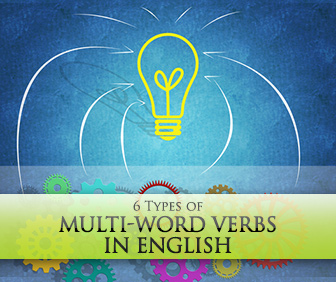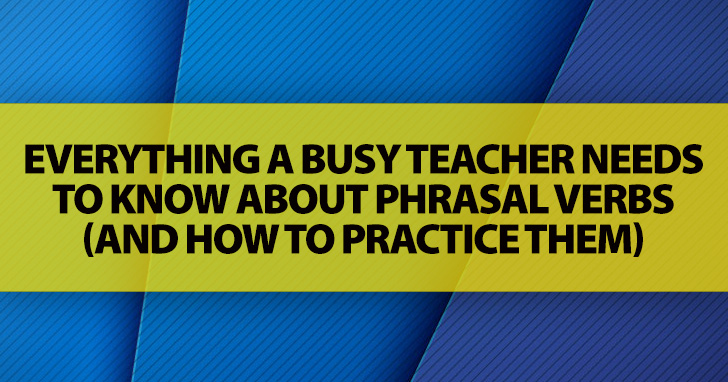Look At, Look Up, Look Into, Look Over: 6 Types of Multi-Word Verbs in English


Intermediate students? Advanced or beyond students?
Besides being the big bad boogey man in the ESL learner’s closet, phrasal verbs, simply put, are verbs composed of two (or more) words. When we think of verbs, we naturally identify them as single units that express an action or state of being. Phrasal verbs, which are often a combination of a verb plus a preposition or a verb plus an adverb, also express an action or state of being. What makes them different from typical verbs, however, is that they use more than one word, and their meaning is most often not related to the words which compose it. For example, the phrasal verb carry on, which means to continue doing something, has nothing to do with the verb carry. It is this unique characteristic of phrasal verbs which makes them so difficult for ESL students to remember and use fluently.
For most, and possibly all, phrasal verbs, a single word verb exists which expresses the same meaning. So why bother teaching (or learning) phrasal verbs at all, especially when they cause students so much frustration? Phrasal verbs are prolific in spoken English. Though they don’t show up as often in formal English or written English, casual English speakers use phrasal verbs without batting an eye. ESL students who do not use phrasal verbs will sound formal or stilted when they speak. They will also struggle to understand native speakers whose use of phrasal verbs is uninhibited. If your students are going to sound comfortable speaking English and if they are going to understand what native speakers say to them, they have to become comfortable using phrasal verbs.
Phrasal verbs also have different characteristics, as do typical verbs. They may be transitive (taking a direct object) or intransitive (not taking a direct object). In some transitive phrasal verbs, the direct object can come between the two pieces making up the phrasal verb. Take the following sentence using the phrasal verb make up: The student made an excuse up for why he didn’t do his homework. For others the direct object must come after the phrasal verb. For example, the expenses added up to $500. In some cases, a direct object in either position is grammatical.

All this may be very interesting and even profitable, but if you are not comfortable teaching phrasal verbs, your students certainly won’t be comfortable using them in their speech. Teaching these important words, though, does not have to be overwhelming. Here are five simple steps you should follow when introducing them to your students. You can use them with students as early as beginners, and the sooner you teach them to your students, the better off they will be when it comes to speaking English fluently.
Sets of about ten phrasal verbs are good numbers to start with. If possible, start with verbs that show physical action and that do not have a common verb (e.g. run for (an office), run through (practice), run out of). Because the meanings of phrasal verbs most often are not related to their components, teaching overlapping sets only confuses students.
If your students are not familiar with the phrasal verbs you will be teaching, and if you are teaching beginners they probably won’t be, read each verb and mime the action for it. As you do, write each verb on the board. Once you have demonstrated all the verbs on your own, give your students commands using those phrasal verbs. For example, if you chose the phrasal verb pick up and its opposite put down, you might tell students to pick up a pencil or pick up their book. Then have them put those same objects down. Make sure your students get a chance to act out each of the phrasal verbs on your list. This step is important for laying a good foundation for learning phrasal verbs. By associating the verbs with their action rather than a one word equivalent, you are establishing these words in your students’ vocabularies in a primary position. If they learn these verbs early on, they won’t be tempted to use single word equivalents because phrasal verbs will be deep set in their English vocabularies.
If you are teaching absolute beginners, you will want to write several sentences fill in the blank style using each of the phrasal verbs. Make sure when you do that you only provide one blank for each phrasal verb to reinforce to your students that phrasal verbs, though more than one word, act as one part of speech in the sentence. Act out each sentence, and have students fill in the blank with a phrasal verbs. If you are teaching intermediate or advanced students, simply act out a sentence that uses a phrasal verb and have your students write out a sentence explaining what you are doing. Be sure to leave the phrasal verbs written on the board behind you. Their answers should read along the lines of the following: The teacher opened up her book. She picked up her pencil. She wrote out the answers to the questions.
Now that your students have seen you act out the phrasal verbs and have practiced writing them, have your students play the teacher. Have each person choose one phrasal verb from your list and act it out for the class. The rest of the class will have to guess the verb that person is acting out. Give each student a turn, if possible, to act out at least one of the verbs.
Now that students have seen the verbs acted out, have had some writing practice, and have acted some of them out on their own, it’s time to put these phrasal verbs to use. Have students write original sentences using the verbs or use them in a speaking activity. Even better, do both. The more your students use these verbs in their written and spoken English, especially if they are just beginners, the more comfortable they will become with them and the easier they will learn additional phrasal verbs.
Phrasal verbs don’t have to be a source of fear for either your students or their teacher. Taking them a few at a time, early in their English studies, your students will build a thorough bank of phrasal verbs in their fluent English vocabularies. If you would like a reference list of phrasal verbs, you can find one here.
Are your students intimidated by learning them?